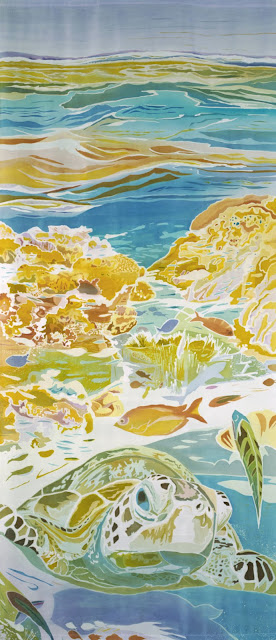| Great Barrier Reef II (Australia), 108″ x 45,” batik on silk. Mary Edna Fraser. |
Artist Mary Edna Fraser has a new exhibit called Our Expanding Oceans at the North Carolina Museum of Natural Sciences in Raleigh. These are beautiful batik pieces designed to use art as a vehicle to share scientific information. Many are featured in a new book, Global Climate Change: A Primer, by Orrin and Keith Pilkey, Duke University Press:
Global warming endangers coral reefs in two ways. If sea level rise is too rapid the reefs will drown and if maximum summer temperatures are too high, fatal coral bleaching (caused by loss of the symbiotic zooxanthellae algae) may occur. Bleaching has already killed portions of the Great Barrier reefs. Fortunately if conditions are right, reefs can recover. —Orrin Pilkey
Mary Edna Fraser tells me of the outcome of her first snorkeling adventure in 2007:
And it was my initiation into underwater photography as well. The batik is a synthesis of that experience which was like flying under water with colors and shapes constantly in motion. This aquatic excursion changed my life forever.
|
Charleston Airborne Flooded, 95.5″ x 35,” batik on silk. Mary Edna Fraser. |
The piece above is of Fraser’s hometown, Charleston, North Carolina. It’s based on a NOAA projection of a 4.5-foot/1.4-meter rise in sea level by the year 2100:
The dark green band along this Charleston regional shoreline is the area that will be flooded after a 4.5 foot sea level rise. The barrier islands along the outer coast have largely disappeared in this projection, though in reality the islands might instead grow narrower and migrate toward the mainland. Anyone planning on a property purchase in this area might be well-served by this beautiful piece of art. Already sea level rise has made the storm water runoff system ineffective and unable to drain the city during a simultaneous heavy rain and high tide. As the shoreline moves inland, so will future storm surge levels and storm waves. All told, coastal living in the lower coastal plain faces a challenging future. —Orrin Pilkey
You can see more of Fraser’s art-science mashups here.
Crossposted from Deep Blue Home.











